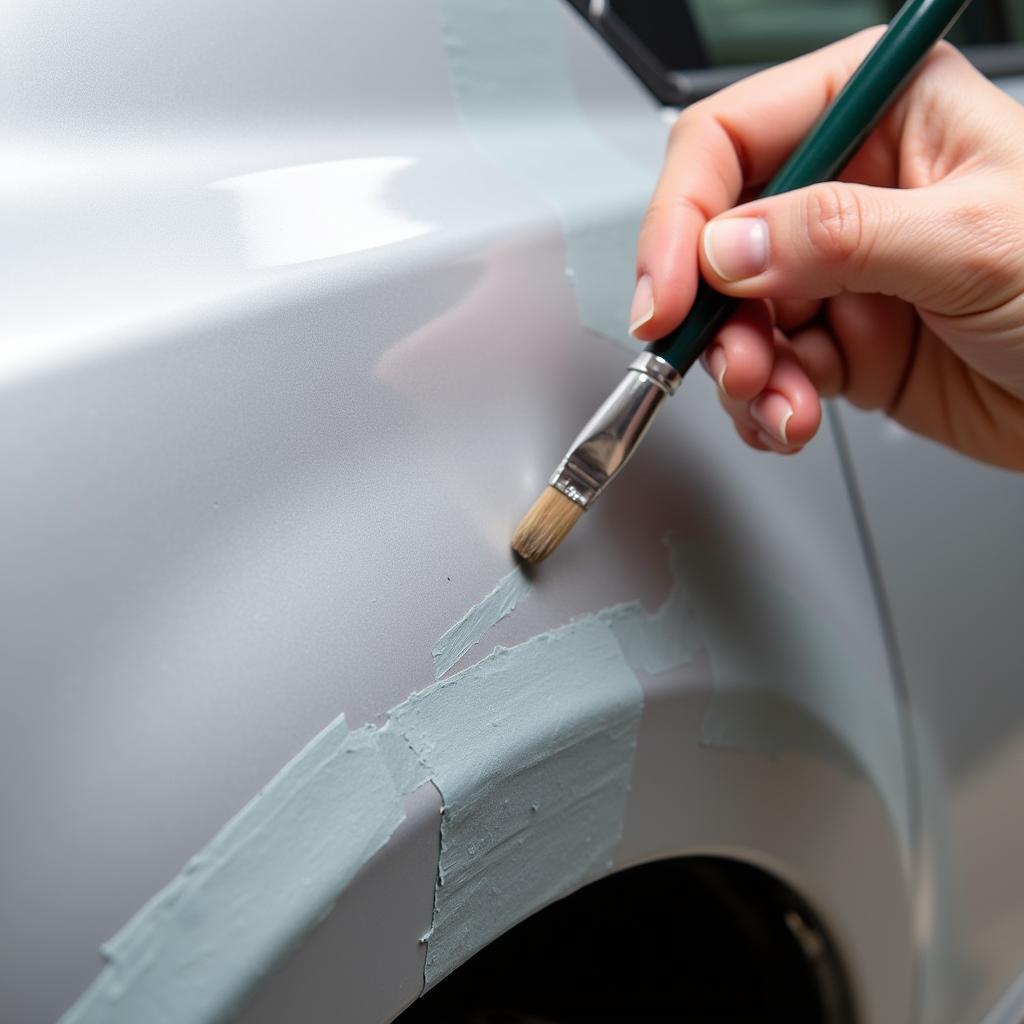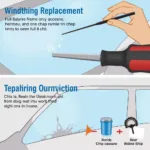Deep car paint scratches are more than just an eyesore; they can expose the metal underneath to the elements, leading to rust and further damage. Understanding how to repair deep car paint scratches can save you money and maintain your vehicle’s value. This guide provides a comprehensive approach, from assessing the damage to achieving a professional-looking finish.
how to repair deep scratches on car paint
Assessing the Damage: How Deep is Too Deep?
Before attempting any repair, determine the severity of the scratch. A light scratch might only affect the clear coat, while a deep scratch penetrates the color coat and potentially the primer or even the metal. Run your fingernail across the scratch; if it catches, it’s likely deep enough to require more than just a simple polish.
What’s the best approach for assessing a deep scratch? Look for signs of exposed metal or primer. If the scratch has reached these layers, it necessitates a more involved repair process. Don’t ignore deep scratches, as they can compromise your car’s paint integrity and lead to more serious problems down the road.
DIY Repair vs. Professional Help: Making the Right Choice
Minor scratches can often be tackled with DIY methods, but deep car paint scratches often require professional expertise. While DIY can be cost-effective, attempting to repair a deep scratch without the proper knowledge and tools can worsen the damage. Professionals possess the expertise and equipment for color matching, surface preparation, and applying the correct repair techniques.
How do you know when to seek professional help? If the scratch is down to the metal or if you’re uncomfortable with the repair process, it’s best to consult a professional. They have the experience and tools to ensure a flawless repair.
Repairing Deep Car Paint Scratches: A Step-by-Step Guide
For those confident in their DIY skills, here’s a breakdown of the steps involved in repairing a deep car paint scratch:
- Clean the Area: Thoroughly wash and dry the scratched area to remove any dirt or debris.
- Sand the Scratch: Use fine-grit sandpaper (2000-grit) to smooth the edges of the scratch and remove any loose paint flakes.
- Apply Primer: If the scratch has reached the primer or metal, apply a thin coat of automotive primer to the exposed area.
- Apply Touch-Up Paint: Carefully apply several thin coats of touch-up paint that matches your car’s color, allowing each coat to dry before applying the next.
- Sand and Level: Once the paint is dry, use fine-grit sandpaper to level the repaired area with the surrounding paint.
- Apply Clear Coat: Apply a few thin coats of clear coat to protect the repair and restore the shine.
- Polish and Buff: After the clear coat has cured, polish and buff the area to blend the repair seamlessly with the original paint.
Preventing Deep Scratches: Proactive Measures
While repairs are possible, prevention is always the best strategy. Regular washing and waxing create a protective barrier against minor scratches. Parking carefully and avoiding tight spaces can also minimize the risk of scratches.
best paint scratch repair deep car
“Protecting your car’s paint is an investment in its overall value,” says renowned auto detailer, John Smith. “Regular maintenance and preventative measures are key to keeping your car looking its best.”
Cost to Repair Deep Paint Scratches: What to Expect
The cost to repair deep paint scratches varies depending on the severity of the damage, the location of the scratch, and the type of car. DIY repairs can cost anywhere from $20 to $100 for materials. Professional repairs typically range from $150 to $500 or more for larger or more complex scratches.
cost to repair deep paint scratches on car
“While DIY can be tempting, professional repairs often offer a more durable and aesthetically pleasing result, especially for deep scratches,” advises automotive expert, Maria Garcia. “The expertise of a professional can save you time and potential headaches in the long run.”
Conclusion: Keeping Your Car Looking Its Best
Repairing deep car paint scratches is essential for maintaining your car’s appearance and protecting it from further damage. By understanding the repair process and taking preventative measures, you can keep your car looking its best for years to come.
FAQ
- Can I use any kind of touch-up paint? No, it’s crucial to use touch-up paint that precisely matches your car’s color code.
- How long does it take for touch-up paint to dry? Drying times vary, but it’s generally best to wait at least 24 hours before sanding or polishing.
- Is it necessary to apply clear coat after touch-up paint? Yes, clear coat protects the repair, adds shine, and helps blend the repair with the original paint.
- What grit sandpaper should I use for sanding a deep scratch? Start with a coarser grit (e.g., 1500-grit) and gradually move to a finer grit (e.g., 2000-grit) for a smooth finish.
- Can I wax my car after repairing a deep scratch? Yes, after the clear coat has cured and you’ve polished the area, waxing can provide additional protection.
- What if the scratch is very deep and has exposed the metal? For scratches that expose the metal, it’s highly recommended to consult a professional for proper rust prevention and repair.
- How can I prevent future deep scratches? Regular washing, waxing, careful parking, and avoiding tight spaces can help minimize the risk of scratches.
Common Scratch Repair Scenarios
- Key scratches: These intentional scratches are often deep and require professional attention.
- Parking lot mishaps: Minor bumps and scrapes can lead to deep scratches if not addressed promptly.
- Tree branch scratches: Contact with tree branches can cause numerous fine scratches and occasionally deep gouges.
Related Articles and Resources
For any assistance or inquiries, please don’t hesitate to contact us via WhatsApp: +1(641)206-8880, or Email: [email protected]. Our dedicated customer support team is available 24/7 to help you.



